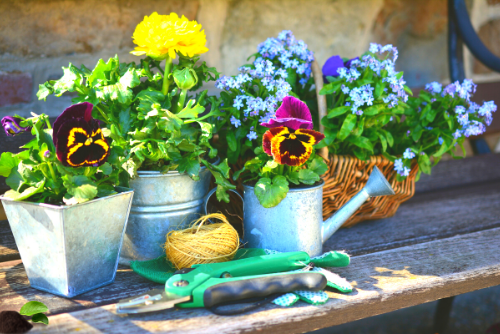We don’t know about you, but we’re ready for sunshine, blossoms, and beautiful gardens! Whether you’re new to gardening or have quite the green thumb, here are some tips to set you and your garden up for success this spring.
1. Soil is Everything
“Some gardeners do not say that they garden, but rather that they work the soil. This reveals an understanding that good soil conditions are essential to support productive plant growth,” says Dr. Lois Berg Stack from the University of Maine. Properly managing soil leads to crop productivity. So, make sure you prepare the soil before you plant. Improve its condition and drainage with compost and organic matter.
To say that rich soil has a life of its own is not an exaggeration. It has its own micro-organism activity (such as earthworms) that breaks down matter to release needed nutrients. Enriching soil with organic matter ensures that it can retain nutrients and moisture while still draining well. Your soil’s structure should be easy to dig, crumbly, and loose enough to provide oxygen for your plants’ roots. When it comes to using fertilizer, use an organic one that adds nitrogen, phosphate, and potash (potassium that plants can use). Here’s more info on how to prepare your soil.
2. Mulch Helps You and Your Garden
Adding a layer of mulch to your garden reduces watering needs, weeding, and it protects the soil. Be sure to lay a thick enough cover of at least two inches. There are different types of mulch you can use. Hardwood bark mulch decomposes into rich, black dirt and has a sweet scent. Alternatively, straw can be used in vegetable gardens and around strawberry plants. It can also help keep mud off of your edible plants. If you decide to go with straw, be sure that it’s free of weed seeds or it can make more weeds grow around your crops.
3. Make Time to Deadhead This Spring
If you have spring-blooming bulbs like hyacinths and daffodils, spend a few minutes deadheading spent flowers. By doing so, the plants send energy to the bulbs instead of into making seeds. Resist the urge to cut the foliage until it turns brown. The leaves store nutrients, which those flowers will need in order to bloom next year.
4. Watch Out For Garden Pests
Thanks to our rainy climate, slugs and snails are common Pacific Northwest garden pests. So, invest in some slug bait. If you’re new to gardening, it’s important to be aware there are many beneficial insects too such as centipedes, millipedes, and ladybugs.
5. Plant According to What Grows Well in Zone 8b
If you’re new to gardening, it’s important to pay attention to the optimal zones listed on a plant or seed package’s label. Here in the Pacific Northwest, we’re in Zone 8b, so be sure to plant a garden full of zone 8b loving flowers, fruits, and vegetables.
Not sure what to plant? Here are some ideas:
- Attract bees and hummingbirds with colorful flowering plants like pansies, petunias, phlox, daylilies, and hardy geraniums. Zone 8 plants that grow best in partial or full shade include bleeding hearts, foxglove, and coral bells (also known as Heucheras).
- Looking for ground cover plants that do well in our climate? Some nice options include hostas, creeping juniper, and English ivy.
- If you’d like to have an herb garden, consider planting lavender, rosemary, oregano, parsley, sage, and mint. However, mint can be invasive, so we suggest using a container.
- Some great early spring and early summer ideas for your vegetable garden include spinach, kale, chard, lettuce, carrots, cauliflower, squash, and strawberries.
6. Consult Your Local Nursery
If you have gardening questions, utilize our local experts. Visit a local nursery! We’re lucky to live in a place with many helpful locals who have years of experience, including the staff at Vallery Nursery in Poulsbo, Bainbridge Gardens, and Bremerton City Nursery.
 Facebook
Facebook
 X
X
 Pinterest
Pinterest
 Copy Link
Copy Link
